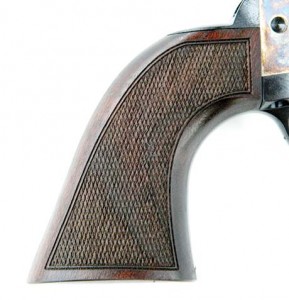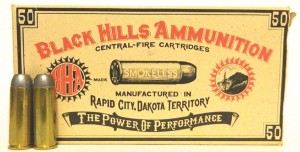by R.K. Campbell | Contributing Editor
I have enjoyed firing and using single-action revolvers for over 40 years. I like the comfortable, well balanced handling. I enjoy handling, loading, unloading and firing these revolvers. Original examples are too valuable to fire and too expensive to obtain for the most part. I use a number of modern replica revolvers of outstanding fit, finish and performance. Many of the early guns were closer to iron than steel in the material used and the modern revolvers are designed to offer good performance and to stand up to the rigors of Cowboy Action Shooting.
Among my favorites is the Traditions Frontier 1873 Single Action revolver. I call this style of revolver the Single Action Army sometimes but usually just refer to the revolver as the Peacemaker. If I happen to be firing one in .44-40 WCF, the handgun is called a Frontier Six Shooter. If you prefer, call it a hog leg or Old Loudmouth. It all fits. The Traditions revolver is made in Italy by Pietta. I have enjoyed excellent luck with this maker. The revolvers are among the best balanced and fastest handling handguns of all time. The original Colt 1873 was delivered to the cavalry with a 7½-inch barrel, chambered for the .45 Colt cartridge. The Single Action Army then was the most powerful, accurate and rugged revolver in the world. The cartridge was designed to give troopers the ability to stop aboriginal warriors with a single shot, but also to drop a war pony at 100 yards if need be. They performed as designed.
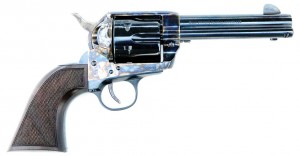
The Traditions 1873 is well made of good material. The tall front sight is just like Bat Masterson liked.
Later the revolver was adopted by lawmen and cattle drivers, but the original barrel length was deemed unwieldy for most uses. The 5½-inch barrel length is a great balance preferred by many. Accuracy is nearly as good as the longer barrel but the shorter tube handles more quickly from leather. Still, lawmen working in town wanted an even shorter barrel cut off with the end of the ejector rod. Thus the 4¾-inch barrel proved to be among the fastest handling and best balanced versions.
I have always preferred this length and the .45 Colt chambering. As for the Traditions revolver, the 1873 balances as well as any cowboy gun. The blue finish is as good as any revolver, regardless of the cost. The case hardened receiver was a necessity with the powerful new .45 Colt cartridge back in the day, and looks gorgeous today. The colors are bright and lively and very well done. The grips are walnut and checkered for good adhesion. I had to carefully consider these grips, as smooth grips and the old Eagle and Shield grips are traditional. For those engaged in Cowboy Action Shooting the checkered grips are the best thing going. They offer good adhesion and abrasion but do not detract from the excellent hand fit of the plow handled grip design. These are a one-piece design with no screws. They really do feel like a plow handle, and that is a timeless and ergonomic design. The fit of the backstrap to the receiver is excellent without overlap.
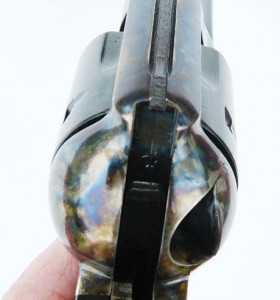
The rear sight is wide enough for rapid acquisition, and the deep groove of rear sight works well in all shooting drills.
The sights are a square notch rear and round front sight. The sight picture was sometimes a problem with only a groove in the front strap. The Pietta sights are well done and offer a good sight picture. The front of the cylinder is radiused, which looks good and also helps in holstering the handgun. Barrel cylinder gap is tight. The trigger action is crisp and light at about three pounds. Timing and lockup leave nothing to be desired. The primary departure from the original cowboy revolver is that the Frontier 1873 features a transfer bar ignition. Original revolvers and many made today demanded that the revolver be carried with an empty chamber under the hammer. The hammer-mounted firing pin would rest on the primer of a chambered cartridge. The transfer bar system uses a frame-mounted firing pin. As you cock the hammer a bar rises and comes between the firing pin and the hammer. The hammer falls and strikes the bar, transferring energy to the firing pin and the primer, firing the revolver. When the handgun is at rest the bar is below the firing pin.
However, unlike some modern renditions, the Traditions revolver allows loading while the revolver is at half cock. While I load all of my single action revolvers with five rounds out of habit and a well-developed desire not to perforate myself, the transfer bar system is a good change.
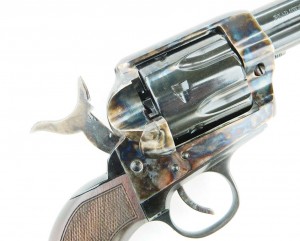
The transfer bar system allows loading the revolver on half cock. The color case hardening is excellent.
There is a wide choice of calibers in the 1873 revolver, including the .357 Magnum, .44-40 and .45 Colt. While the .357 Magnum, loaded with .38 Special ammunition, is a very popular choice for competition use, I prefer the grand old .45 Colt cartridge. It was good enough for Bat Masterson and Tom Threepersons, so it should do for me. The cartridge is accurate enough, particularly when my handloads are loaded with Trailboss powder and a hard cast Oregon Trail 250-grain bullet. This revolver came from the factory with excellent sight regulation for the 250-grain bullet. I appreciate that. These days I seldom have the time to handload and rely primarily upon Black Hills Ammunition cowboy loads. The 250-grain .45 Colt load from BHA runs about 750 fps from this revolver. The powder burn is clean, a neat trick with a cartridge that is notoriously difficult to load well with smokeless powder. The Black Hills load will exhibit a 2.5-inch group at a long 25 yards if I do my part, which is most of the time. This load would be an ideal choice for cowboy action shooting and recreational use.
Quite a few shooters keep a single action revolver on hand for personal defense. If you are familiar with the action through cowboy action shooting or simply prefer the type, there are worse choices. Winchester’s PDX load uses a 225-grain JHP at over 800 fps. This load has demonstrated excellent accuracy. Expansion is good, recoil is mild and overall this is as good as it gets in a home defense cartridge.
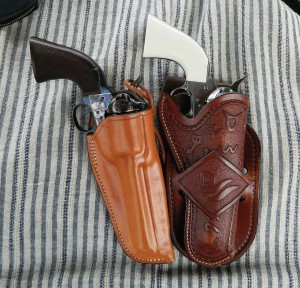
The Lobo Gunleather Tom Threepersons holster and the Rocking K Saddlery Diamond Loop Cattlebrand holster solved a lot of problems for the author. And the pair of Piettas are a securely carried.
When carrying the Traditions revolver just any holster will not do. The Rocking K Saddlery Diamond Loop Cattlebrand holster is an extraordinary mix of history and art. Far from a basic Mexican Loop, the Cattlebrand holster features a diamond pattern loop. The holster is covered with popular cattlebrands of the Old West. Few working cowboys would have owned such a holster but experienced lawmen and cattlemen would have. The fit, finish, and stitching are flawless. This is one of several holsters I own from this maker, and all show good workmanship. (online: Rockingksaddlery.com) The selection of authentic holsters from this maker is excellent. I also sometimes carry one of the Piettas in a modern rendition of the Tom Threepersons holster from Lobo Gunleather. This holster rides high, offers good fit and excellent speed. When worn under a long jacket, the SAA is well concealed as Tom Threepersons intended.
I own two Pietta revolvers. The other is a modern stainless steel version with white grips. It is a great gun and after much use the trigger is perhaps slightly smoother than my new case-hardened revolver. I like the looks of the new gun better. I also like the grips much better. The other handgun’s grips are a bit too slick at times and the white grips show powder and grime up terribly. But it isn’t going anywhere.
With a few hundred cartridges fired in the Traditions revolver my impression is good. The 1873 is well made of good material, accurate, well suited to cowboy competition. The appearance is traditional but the transfer bar mechanism is a good feature. This is a lot of gun for the money. MSRP $544. (For more information, visit: Traditionsfirearms.com, or phone: 860-388-4656.)

